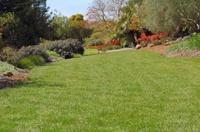Submitted by Rainie on
Director of the Arboretum, Professor Emeritus Thomas Eltzroth, called guests and students to gather in front of the gazebo for introductions, and a toast to the evening's festivities. He gave a brief overview of the arboretum's development, introduced students and fellow colleagues, then honored the distinguished and generous sponsors whose contributions of time, energy, funds, and materials make Leaning Pine’s continued growth possible. Minutes later individuals mingled in groups, and moved about for a closer look at the Mediterranean regions and their plant collections. I decided to begin my walk in the formal garden where I could view topiaries, and signage that helped me to identify the species. Junipers spiral into corkscrews, golden cones, and blue pyramids. Japanese boxwoods form hedges, and columns of cypress converge to create a welcoming entry that drew me further into the garden, like Alice into Wonderland.
Across the adjacent lawn, a path led to the palms, and an intriguing array of aloes, from the diminutive to those towering above my head. I browsed through the Australian section where bottlebrush, banksia, and tea myrtle cover one bank. Bluebell creeper, knife-blade wattle, and grass tree meander along the opposite berme. Parts of the garden boast a multitude of colors, some as vibrant as those on a Van Gogh painting. In the Mediterranean Basin section, scents of lavender elicit images of southern France. Continuing to the New Zealand plant community I brushed past bobbing blossoms of snowflake, stream orchids, and strap-like leaves of flax, through which the glimmering evening light shone bronze. Each region offered its own unique appeal, demonstrating the rich plant palette that arises from semi-arid climates.
Walking further up the arboretum I could see revealed the subtleties of our western flora, and expansive views of the Santa Lucia Mountains. I admit to favoring this native garden, as I remembered from past visits, its varying seasonal changes, from cool lakes of blue California lilac, to pear-like fruits that hang against the white silhouette of buckeye like ornaments on a Christmas tree. Contrasting textures of rocky outcroppings, oak forest, and prairie create a smaller canvas against nature's backdrop. Honey-colored sycamore trees in fall, dry creek beds, and rocky chambers await winter rains. These are just a few signatures that bind the surrounding hills and canyon to the California native garden, luring a visitor’s gaze from the arboretum to the wild beyond.
In conversation with Professor Eltzroth that night, I commented on the striking flower arrangements that decorated one of the tables. He informed me that they were obtained from the Eucalyptus against the fence line on the hill. “I think you planted some of those trees” he said. Looking up to where he was pointing, I suddenly remembered a weekend project thirty years earlier, planting with my husband who was a graduate student at the time, and complaining about the difficulty of digging in clay soil. Until that moment I had forgotten my personal involvement. The arboretum was then in its infancy, making the growth and change since, all the more dramatic. Continuing with other guests through the flora of five continents represented, we sipped wine and tasted hors d’oeuvres prepared in the ethnic cuisine of each region. The entire experience was a reminder to me of this precious community resource, prompting me to write about the event, and commit to revisiting Leaning Pine with greater frequency. The evening culminated with a formal dinner served on campus at the Performing Arts Center.
Conceived by the Ornamental Horticulture Department in the nineteen sixties, the arboretum makes education its primary mission, providing a hands-on laboratory and learning tool for students, professionals, and public citizens, to explore the garden's design features. With gardening on the forefront and water conserving efforts a central issue in our state, Leaning Pine has adopted progressive steps, such as replacing part of the traditional lawn with drought tolerant native sedges. Throughout the year the arboretum hosts cultural programs, social events, workshops. Far from separate and isolated, it is the subject of conversation in the community at large.
Now, four decades since its inception, Leaning Pine has also become a focal point on campus. I visualize the garden maturing and growing, with fingers reaching up Poly Canyon. Working in conjunction with other departments at the University, does not seen beyond its scope. Imagine fostering a children's garden in conjunction with the child development department, or hosting an eco-psychology gathering in the council ring. With continuing sponsorship and enriching ideas, the Leaning Pine Arboretum will remain for the community of San Luis Obispo County in perpetuity, but to simply visit at dusk and encounter wildlife such as birds, jackrabbit, coyote, and deer, or find respite in the shade on a hot September afternoon, is enough reason to stroll along its half-mile self-guided tour.




